Personal Report of
ETRIA TFC 2016
Introductions to Individual Papers:
Mar. 24, 2017 (in English)
Personal Report of
ETRIA TFC 2016 |
|
| B. Integral Use of TRIZ with Relevant Methods (11 Papers) | |
| Toru Nakagawa (Osaka Gakuin Univ., Japan), Mar. 24, 2017 (in English) |
|
| Posted on Mar. 30, 2017; Updated: Apr. 1, 2017 |
For going to Japanese pages, press buttons.
Editor's Note (Toru Nakagawa, Mar. 24, 2017)
This is a part of my 'Personal Report of ETRIA TFC 2016', whose main page
was posted on Feb. 14, 2017. The Section (5) Introductions to Papers is going to be posted in 7 HTML pages, categorized with their topics for easier access.
A. Methodology of TRIZ
(Mar. 30, 2017)
B. Integral Use of TRIZ with Relevant Methods(the present page) (Mar. 30, 2017)
C. Case Studies in Industries(Apr. 24, 2017)
D. Promotion of TRIZ in Industries(Jun. 4. 2017)
E. Usage of TRIZ in Education and in Academia(Jun. 4, 2017)
F. Patent Studies(Jun. 21, 2017)
G. Applications to Soft & Non-technical Areas(Jun 21; Jul. 18, 2017)
Editor's Note (Toru Nakagawa, Mar. 29, 2017) Most figures are shown here from the Authors' slides under the Authors' permissions. Several of the figures in this page are blocked temporarily. They are taken from the Authors' full text in the Proceedings (when proper slides are not available). I am asking for the permission of citing them here to the copyrighters, i.e., the Authors, ETRIA Board, and the Publisher (Elsevier or Springer).
B. Integral Use of TRIZ with Relevant Methods
![]() marks are highly recommended.
marks are highly recommended.
B1. Cause-Effect Chains Analysis using Boolean algebra
Jerzy Chrząszcz, Piotr Salata (Warsaw Univ. of Tech., Poland; Pentacomp Systemy Informatyczne S.A., Poland) ![]()
This is a theoretical and clearly explained paper, and has obtained the Best Paper Award of the conference. The Authors' Abstract states as follows:
Cause-Effect Chains Analysis (CECA) usually results in a diagram showing particular effects with arrows denoting causality and logical operators, reflecting interrelation between causes implying particular effects. Intended outcome of the analysis is to identify root causes triggering observed surface problems. From this point of view the resulting model may be considered a set of functions interrelating occurrence of key disadvantages and initial / target disadvantages.
This paper describes the concept of modelling Cause-Effect Chains with Boolean functions. Such approach allows for direct application of techniques used in the area of digital circuits design and testing. Provided examples demonstrate how the proposed logical model may support decisions regarding changes in the analyzed technical system.
The basic approach of the present paper is to understand that the CACE model consists of Contents and Structure. Though the Contents (or descriptions in the nodes) need to be understood specifically to the problem, the Structure of the the CACE diagrams can be handled generally according to its logic, which is essentially equal to the Boolean algebra also used for expressing digital circuits.
The Authors demonstrate how to clarify the structure logically by using a model case shown in Fig. 1. The nodes k1 to k8 stand for key disadvantages (or root causes) while those t1 to t4 for target disadvantages (or undesirable effects). The logical relationships are shown with the lines (or arrows from left to right) and the AND/OR nodes. Intermediate nodes are just shown with empty boxes because they are irrelevant with the logical structure. The CECA model (Fig. 1) can be transformed into the equivalent logical model (Fig. 2), where the intermediate nodes are expressed with triangles meaning straight-forward propagation of the logic.
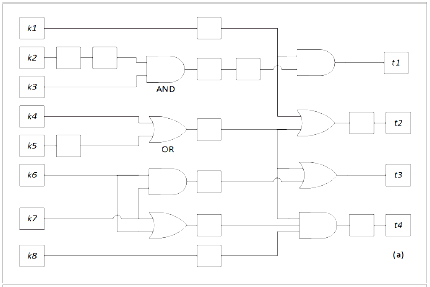 ==>
==> 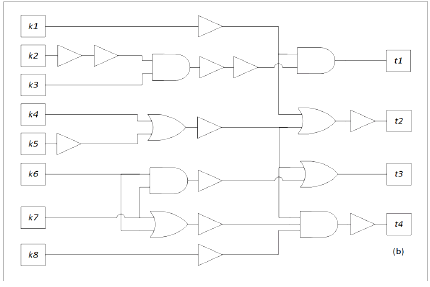 ==>
==>
Then noticing that k3 and k4 are complementary (i.e., k3 = NOT k4) and also k7 = NOT k6 in this case, the NOT gates are introduced after eliminating k3 and k6 (Fig. 3). Chains of repeaters (i.e., triangles) are then simplified into single repeaters (where dotted triangles are neglected) (Fig. 4).
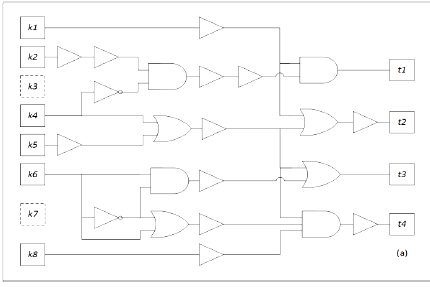 ==>
==> 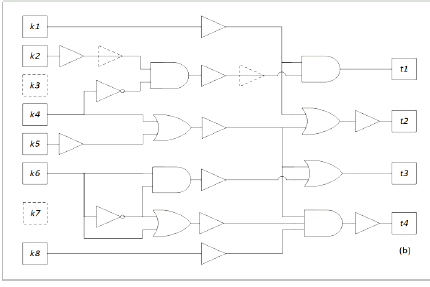 ==>
==>
Repeaters are further neglected into simple lines (or implicit arrows), as in Fig. 5. Noticing the identities that k6 AND NOT k6 = 0 (or False) and k6 OR NOT k6 = 1, etc., the logical model has been minimized into the one in Fig. 6.
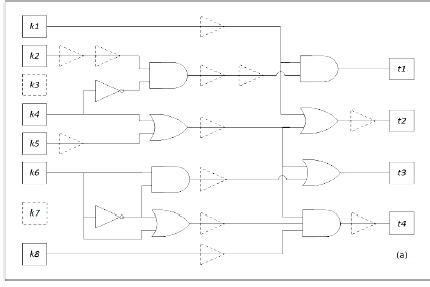 ==>
==> 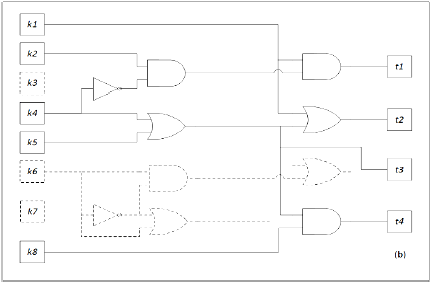
The final logical model (Fig. 6) represents the root-cause relationships as: t1 = AND (k1, k2, NOT k4); t2 = OR (k1, k4, k5); t3 = OR (k4, k5); t4 = (k4 OR k5) AND k8. In this manner the logical structure of the CACE model (Fig. 1) can be understood clearly.
The final results thus obtained can be readily used to answer the following questions, the Authors say:
Which inputs influence particular output?
Which inputs have the greatest influence on outputs?
What minimal set of inputs must be acted upon in order to deactivate particular output?
What minimal set of inputs must be acted upon in order to deactivate all the outputs?One of the limitations of usage is the case of loops. In the case of a diagram having a loop shown in Fig. 7(a), the Authors recommend the linearization in the form (b), while the conversions into AND condition (c) and the reduction (d) may be used.
B2. Trend of Increased Addressing of Human Senses - Near Field Senses –
Oliver Mayer (GE Global Research, Germany)
The Author's Abstract is cited here after omitting a few sentences shown with '...' for the sake of clarity.
One of the key results of Genrich Altshuller’s research is the definition of Trends of Engineering Systems Evolution (TESE). ... This paper suggests adding another viewpoint to the Trends by not only considering the development of technical system themselves in a technical environment, but by focusing on the interaction of a technical system with users and the thereof resulting requirements and development directions. ... Following this view the human being is the super system and even the target for the engineering system. The interaction between both is done by the senses of the human being. ...
Alexander Lyubomirskiy has shown in his research that there is a trend of “Coordination of images”. This trend is focusing on only the visual sense of a human being. This study suggests expanding this approach to all human senses, auditory, kinaesthetic, gustatory and olfactory. With this the complete human interface towards technology and the world is addressed.
This paper discusses the systematic approach to this evolution. It will display the human senses and relate to supplementary senses for animals. The way that technical systems are constructed to impact the senses and the evolution over time on how this is done with technical systems will be shown. Finally, the usage of other trends (e.g. dynamization) to focus the impact of the technical system to the human senses will be discussed. The final point will be the development of technical systems to address several senses at the same time.
Human senses are summarized in the table (right). Seeing comes from the work by A. Lyubomirskiy, while four other senses are the results of the present study.
The slide shown below left is illustrative to the basic evolution trend of 5 senses. It also show the discrimination of More conscious long-distance senses (i.e., seeing and hearing) from More unconscious short-distance senses (i.e., touching, tasting, and smelling).
The Author summarizes four application categories of trend of human senses; they are:
Increase of sense impact, Decrease of the sense impact, Change of direction of sense impact, and Combine senses. (below right) (Note (TN, Apr. 1, 2017): The table is taken from the paper and is temporarily blocked in order to get the copyrighters' permissions)
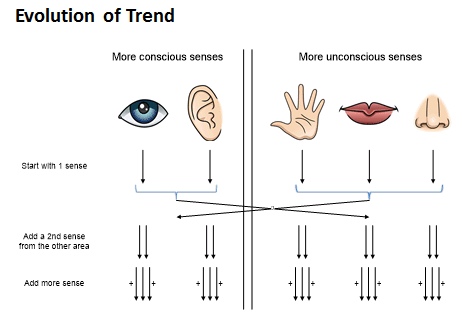

B3. Lessons for TRIZ from Design Thinking & Lean 3P
Michal Halas (Grupa ODiTK, Poland)
The Author's Abstract is very clear and straightforward, as shown here:
Design Thinking and Lean 3P are good examples of New Product Development processes. Author is looking from the perspective of a training company at Design Thinking and Lean 3P as training/consulting products present on the market. Assuming the knowledge of TRIZ of the reader, this article is showing convergence of Design Thinking and Lean 3P with their strengths and weaknesses. Both processes are compared to TRIZ and lessons for TRIZ community are extracted: TRIZ is only a sophisticated idea generating engine, and it is not a complete New Product Development process, but can compensate weak innovation engines of Design Thinking and 3P.
The Author explains the processes of Design Thinking, which has been promoted by Stanford University, as shown in the figure (Source: educate78.org):
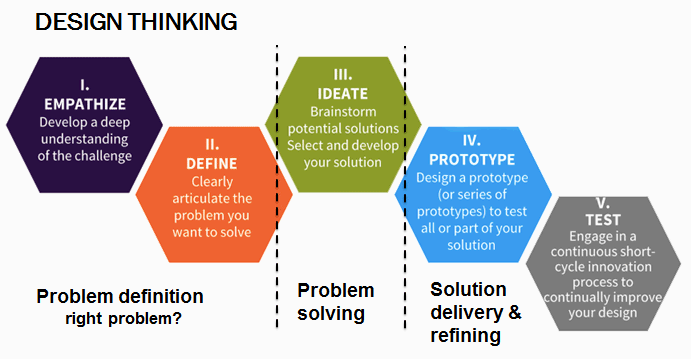
Lean 3P (Production Preparation Process) was developed in Japan since 1960s as a part of Toyota Production System. While Lean (Manufacturing/Engineering) intends KAIZEN, i.e., to improve gradually and continuously, Lean 3P intends KAIKAKU, i.e., to change with breakthroughs revolutionary. The Author explains the 3P process as shown in the Figure shown below (Source: Mike Browlewski_Gemba Consulting_LM.pdf at www.reliableplant.com).
The Author points out the strengths and weaknesses of these methods, as summarized in the following table.
Design Thinking
Lean 3P
In common
Strengths
1. Empathize – how the user feels?
2. Flexible and simple
3. Quick wins
4. Agile prototyping
5. Good marketing
1. Lean results
2. Cheap workforce - close to final users
3. Gemba (close to workshop)
4. Moonshining – around bureaucracy
5. Agile, quick prototyping
1. Strong in employing final users.
2. Horizontally complete processes
3. Cutting development time by doing trials
4. Using simple creativity tools
Weaknesses
1. Limited area of use
2. Poor creative engine
1. Rigid structure
2. Low popularity
3. Limited area of use
1. Weak as creative engine
In conclusion, the Author writes the lessons for TRIZ from Design Thinking and Lean 3P as:
(a) Synergy of TRIZ (especially as the solution generation engine) with Design Thinking or Lean 3P (as the complete process).
(b) TRIZ as sophisticated engine -- not a complete process. (TRIZ should not claim to substitute Design Thinking or Lean 3P)*** The Author's conclusion is similar to the findings "Lean-TRIZ instead of TRIZ-Lean" by C. M. Thurnes and F. Zeihsel (ETRIA TFC 2013)
. This point can be understood more clearly and generally by referring to Nakagawa's 'Six-Box Scheme' of Creative Problem Solving.
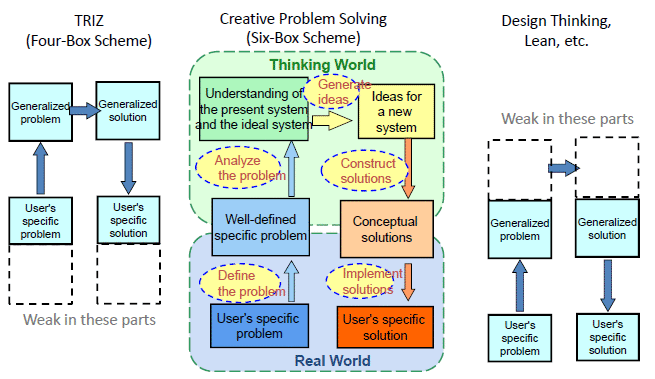
B4. What a well-trained TRIZ user can learn from other design methodologies: an initial speculation
Leonid Chechurin, Mika Lohtander (Lappeenranta Univ. of Tech., Finland), Yuri Borgianni (Free Univ. of Bozen-Bolzano, Italy)
Though the title is wider in scope, the paper actually focuses on the relationship between Axiomatic Design (AD) and TRIZ. The Authors' Astract is quoted here first.
A typical list of conceptual design tools in engineering consists of the following approaches: TRIZ, axiomatic design (AD), design for X, Robust Design and some others. The present paper focuses on two popular methods that include a rich theoretical background, i.e. TRIZ and AD, which are selected for a pilot experiment. They are normally treated as separate design techniques in the literature that recommends their integration only.
To which extent can AD approach be seen as a particular case of the whole TRIZ body of knowledge and vice versa? The research question is to define the relationships between these methods, whether they overlap, which one is more general or specific and could be derived from another one. We provide comparative review on these methods to define their inputs, outputs and the rigidity of technique. Then, we discuss a set of classical AD-driven idea generation examples and approach them with the help of TRIZ. We discuss how AD axioms can be interpreted by TRIZ principles.
We conclude that AD solutions can be viewed as particular cases of the whole body of TRIZ tools to support inventive design, but AD way of thinking results helpful to accelerate the design process. The results can be used to improve the design roadmap, to approach the general TRIZ-based concept design theory and a better logic of teaching. In addition, the paper proposes this kind of investigation for expanding this study, so to include different perspectives, other case studies and additional methodologies.
Axiomatic Design (AD) is unique to encourage the designers to avoid solutions in which more Design Parameters (DPs) are responsible for the fulfilment of one or more functions (or Functional Requirements (FRs)). Under such principles, AD has shown nice examples of good solutions. The present paper discusses whether and how TRIZ can derive such solutions by using 2 cases of problems.
The first is the Faucet Problem: The traditional faucet has two handles for hot and cold water separately. It is difficult to adjust the flow quantity and temperature of water smoothly because each of the two handles changes these features. The inventive, but now well-known, solution fit with AD is shown in the figure. The present Authors check whether original TRIZ tools can derive such a solution smoothly, and found rather negatively, as shown below left.
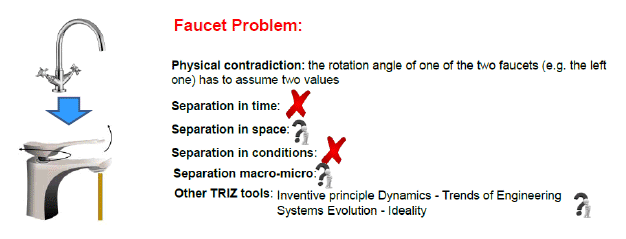
The second is Air Conditioner Problem. For setting an Air Conditioner on the wall, it is important to set it precisely horizontally. The ordinary way of using two nails are not convenient for precise setting. AD advises the solution of using one main nail for supporting the weight and a second small nail for adjustable horizontal setting. The Authors' evaluation of the usage of TRIZ tools is rather negative as shown in the figure below.
Please refer to the Authors' conclusion in their Abstract (see above). The AD way of thinking is helpful for accelerating the design process (or finding inventive solutions).
*** I agree with the Authors' view. We should be open-minded and flexible in using various methods and principles for solving our problems. In the sample cases mentioned above, we should better use the functional analysis and think of ways to perform the required functions appropriately; it is a natural way of incorporating AD in the problem solving process. Inventive Principle 17. Another Dimension may be suggestive to the AD-like solutions.
B5. The Application of TRIZ to exclude Product Failures caused by unintended Operation Errors
Juergen Hess (BSH Home Appliances Group, Germany) ![]()
The Author's Abstract is quoted here:
Products that are obviously robust against unintended operation errors fulfil one basic requirement for being economically successful. This article concentrates on the TRIZ supported treatment of product failures which are caused by unintended operation errors. An effective approach to counteract unintended failures has been introduced for production processes, known by the Japanese expression Poka Yoke. Synergies between the Poka Yoke approach and TRIZ are highlighted and discussed. Based on typical patterns of operation errors by end-customers a general proceeding is worked out. Special emphasis is paid to the identification, the comprehension and the counteraction of failures caused by unintended operation errors.
This is a nice overview paper for designing products robust or preventive against users' careless human errors. Poka Yoke is a basic approach coming famous from Toyota Production System. Poka means careless/unconscious human errors in some operation, and Yoke (coming from the verb Yokeru) means avoiding/preventing. Poka Yoke has been developed and applied much in the products manufacturing processes, where the tools and equipment are carefully improved, the processes are rearranged, and the workers are trained well with manuals, etc. TRIZ may be used in this kind of improvements.
The Author addresses the failures of products in its lifecycle at the customers. The graph (right) shows Failure occurrence depending on time for a typical home appliance. (Note TN, Apr. 1, 2017): The figure is taken from the paper and is temporarily blocked in order to get the copyrighters' permissions.) 3 types of product failures are noticed: Early failures (gray in the figure) can be assigned to weak design/assembly/maintenance etc. and can be counteracted. Random failures (dotted) occur throughout the whole lifecycle, very often due to unintended operation errors by customers. Wear-out failures (hatched) occur in the later life of a system due to enduring harmful load or stress to the system. The random failures occupy typically 60 % of all product failures. The Author writes: "Many organizations tend to exclude end-customer's operation errors from manufacturer's compensation obligations. ... In many cases end-customers are not willing to accept their responsibility for unintended failures. ... Therefore the requirement emerges that products must be robust against unintended operation errors."
By use of Cause-Effect diagram, the normal operation can be expressed in the figure (below left), while failure operation in the figure (below right). Conscious transaction (in accordance to the operation manual, etc.) results in a useful intended effect, but unconscious transaction (out of normal operation, in error) results in a harmful effect and in failure. Unconscious transactions may be missing vigilance, for example caused by mental absence, misunderstanding, miscounting, forgetting, over-seeing or unnoticed impact by exterior disturbances, the Author writes.
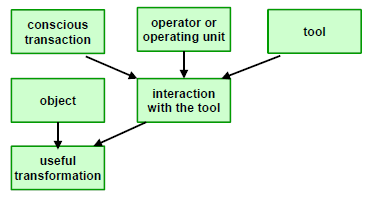
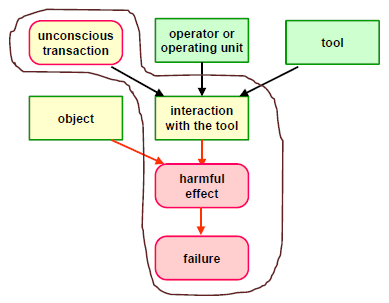
The failure modes caused by the interactions with the end-customers are substantially different from those caused in the production process. For example, end-users might not read the operation manual carefully, use tools properly, carry out maintenance properly, and the environment where they use the product is not defined at all. Thus there are substantially more failure possibilities for product operation errors by the end-customers.
The Author recommends the following procedure of integral use of Poka Yoke and TRIZ for preventing from product failures of random type:
(1) Failure Analysis: FMEA (Failure Mode Effect Analysis) and FTA (Failure Tree Analysis) may be useful.
(2) Verify the Failure mechanism: AFD (Anticipated Failure Detection) in modern TRIZ may be used.
(3) Elimination of problems causing failures: Any TRIZ tools, e.g. inventive principles, standard solutions, etc., may be used.
(4) Validation of effectiveness under realistic conditionsThere are numerous examples of Poka Yoke solutions against operation errors by the end-customers in the daily life, E.g., Fast fuses, Write-protection switch of (former) computer disks, Front-window of a washing machine functioning as an on/off switch of rotation, etc.
B6. A Praxeological Model of Creative Actions in the Field of Mechanical Engineering
Maksymilian Leszek Smolnik (AGH Univ. of Sci. and Tech., Poland)
This is a theoretical paper and I choose to show the Author's Introduction slide first to understand the terms in 'Praxeology':
Here are the first two paragraphs of the Author's Abstract:
Praxeological models allow one to design, evaluate or modernise the systems where different actions are performed in order to achieve the desired goals. The mentioned models aim at increasing the effectiveness of the performed actions, which generally is the main field of praxeology considered as science.
Application of the praxeological models to the actions taken within the creative process (especially within machines designing process) is presented in the paper. The main aims of the paper are as follows:
The basic unit of Praxeological Model is an (Action) Chain of Subject - Action (Tool) - Object, as shown with specific shapes of nodes (below left). Subjects must be people, while Tools and Objects may be anything including people. The units may be combined to represent the relationships of actions, by identifying a Tool in a unit same as an Object in another unit, as shown in the figure (below right).
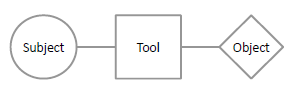
By use of this representation method the Author has built Models of various processes of actions. Here are the last two paragraphs of the Author's Abstract:
The obtained model may be used during the synthesis or the analysis of designing systems, designing processes or designing methods in order to provide the better effectiveness of the actions being performed. Therefore, it may be considered as a tool of designing methodology. It clearly presents the subjects, the tools and the objects that are essential for conducting the mentioned process as well as the interactions between these elements.
The model may be used in order to organise the actions while designing: technical objects, manufacturing processes, operation or maintenance processes as well as disposal processes. It was built in the way that allows one to easily introduce TRIZ during all of the listed designing actions.
The Model of 'Creative actions in the field of mechanical engineering' is constructed as shown below. The Designers appearing in 7 different places can be a same single Designer. Various types of people besides the Designer(s) are involved in the Designing process.
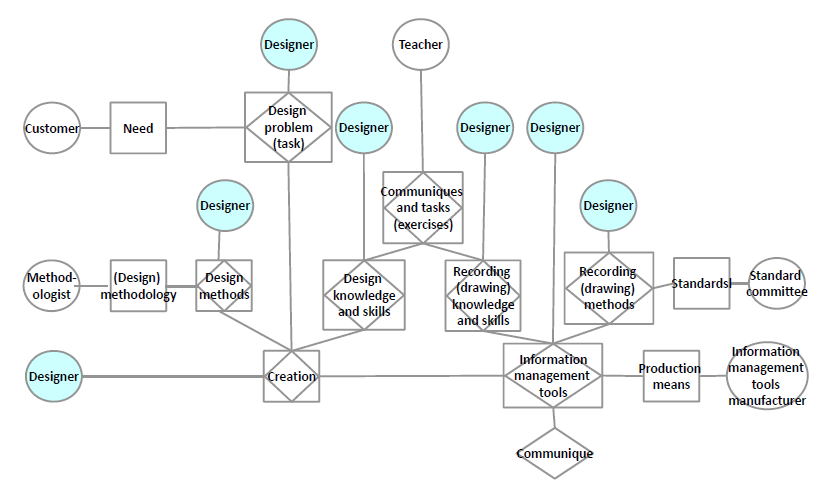
The Author specifies the diagram one more step to show 'Model of designing a manufacturing process of a combustion engine crankshaft', by using the exactly same structure.
*** This representation may urge us think of the fact that many different types of people are involved in various activities.
B7. Can TRIZ functional analysis improve FMEA
Christian Spreafico, Davide Russo (University of Bergamo, Italy) ![]()
The Authors' Abstract is cited here first:
Since its introduction, Failure Modes and Effects Analysis (FMEA) is one of the most universally approved techniques for failure analysis, and is applied in a multitude of different industrial context: mechanic, chemical, electronic, etc. However, in literature some common requests of improvement are moved to traditional FMEA. A detailed survey covering 150 journal papers and 109 patents between 1978 and 2016 indicated Failure Modes detection as a critical issue. We found some interesting attempts to answer this request by introducing TRIZ.
From these, a new TRIZ-based FMEA approach is presented. In this work the original FMEA ontology is maintained but partially revised, the order of execution of the phases is reversed, and specific TRIZ tools are integrated. More in particular, an inedited version of TRIZ functional analysis, called “Perturbed functional analysis”, and the Film maker (an evolution of the well-known TRIZ Multiscreen tool) are proposed in order to improve the capability of determine Failure Modes, Causes and Effects. An exemplary industrial application on vacuum cleaner is proposed to show this approach.
The case study of applying to a vacuum cleaner demonstrates well the new process of proposal, as shown here from their presentation slides. The vacuum cleaner is designed to have a special feature of compacting the aspirated dust in samples, by the user's manual operation, instead of collecting in a bag. The proposed process consists of 6 steps as follows.
The process focuses on the main useful elements, instead of all the elements, of the system for the sake of efficiency. In this case the elements related to the special feature are considered. In Step 1 the feature is shown with the Function Analysis, in the standard way of TRIZ.
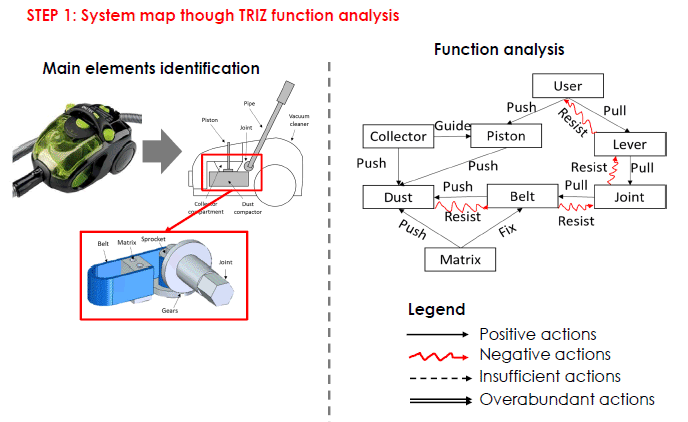
Then in Step 2, we consider various failure modes. For this purpose, the list of noise factors in the Taguchi Methods, or robust design, is useful. The noise factors, as shown in the table, may be applied to various elements in the Functional Model to think of possibility of triggering some failure modes. (Note (TN, pr. 1, 2017): The table is taken from the paper and is temporarily blocked in order to get the copyrighters' permissions.) Here we may think of the Joint being broken, as a failure mode.
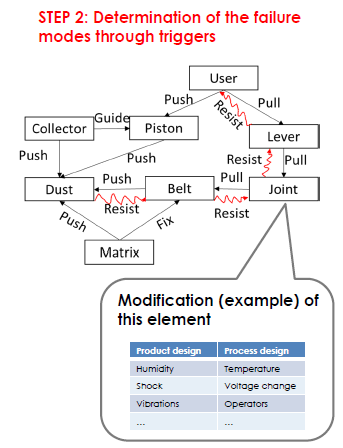

Then in Step 3, the Functional relationships of the system may be perturbed (according to the Failure mode), as shown in the following figure, representing the Failure Effects.
Next in Step 4, the Failure Effects are considered more closely. What type of things may happen as the Failure Mode? And the Failure Mode may be redefined, in a more specific manner. What kind of effects may be caused as the results of such Failure? Consideration of critical time and space is useful.
In Step 5, we consider what can cause such a Failure Mode. For this purpose, the subversion analysis in TRIZ is useful, where we aggressively think to invent some ways to cause the Failure, instead of ways to prevent from it, by full use of various internal/external resources. The concepts of the Noise Factors (shown in Step 2) are also useful. 'Film Maker' mentioned in the Abstract is a method to visually think of the process (or scenario) of causing the failure.
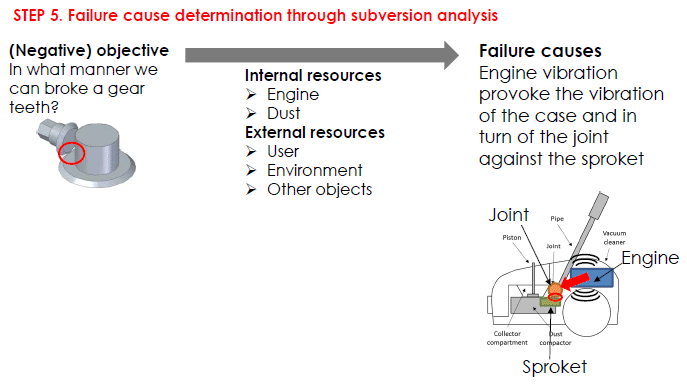
Now that we have identified possible Failure Causes, we go ahead to find various solutions of preventing from the Failure by using standard ways of TRIZ problem solving methods. An example is shown below.
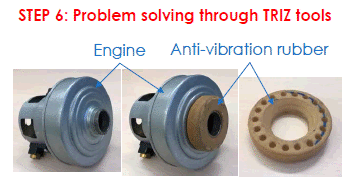
In all the steps above, there can be many alternatives of Failure Modes, Failure Effects, Failure Causes, and Solutions. Thus we should think of their priorities and concentrate our efforts onto important ones. The Authors demonstrate the examination of the effectiveness of the proposed method in the paper/slides.
*** This method seems very smooth. The intentions of the steps are clear, and the actual ways of thinking are well guided. Original FMEA, TRIZ, and Taguchi Method, etc. are well integrated.
B8. Effective Design Approach with Inventive Principles to Reputational Damage Risk on the Internet
Manabu Sawaguchi (Waseda Univ., Japan), Satoru Utsugi (NS Solutions, Japan) ![]()
The Authors' Abstract is cited here first:
In recent years, we have increasingly witnessed flaming on the Internet where reputations that had spread via the Internet media brought risk to the management of companies. Such cases have been increasing every year, and concerns over reputational damage risk among companies have also been rising. Based on that background, this paper proposes a risk management method utilizing design approach to plan effective measures against reputational risk at appropriate cost levels.
This methodology consists of two phases: Phase 1 to classify all risks and rationally select high risk areas, and Phase 2 to use design approach to work out measures with consideration of even unknown risks. The largest characteristics of the risk management proposed in this paper are the rational visualization of unknown risk areas with higher degrees of danger, and the design of unknown risks that cannot be found with conventional risk management methods which focus on the examination of past cases.
The paper and presentation slides are written well logically. So I will cite several figures of them, with relatively brief introductions. Intention of the present study is expressed in the following figure with the emphasis of covering unknown potential risks.
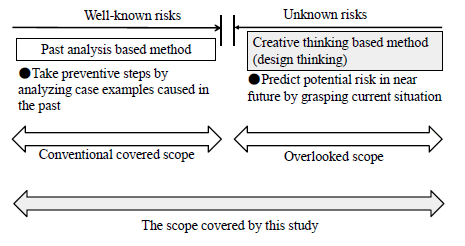
Then the overview of the present proposal is shown below:
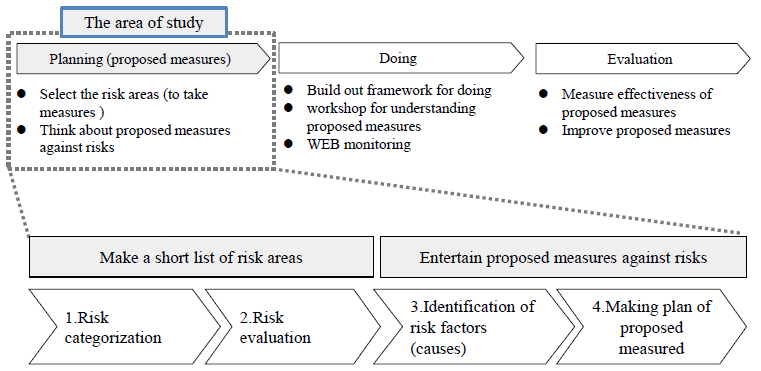
The risk management method proposed in the present study is compared with the conventional one, by mentioning the basic approaches along the 4 steps.
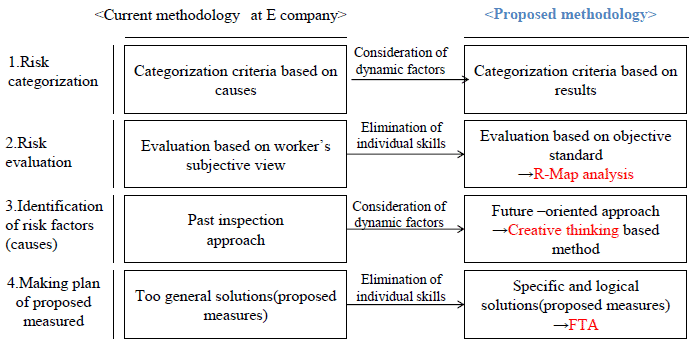
Step 1 is Risk Categorization. In the present case, various articles potentially relevant to company's (bad) reputations appearing in the Internet are gathered and categorized, as shown in the table:

Step 2 is Risk Evaluation. Potential risks of various reputation types are evaluated with the combination of 2 criteria, i.e., degree of danger and frequency of incidence. The risks in the red zones need to be addressed seriously.
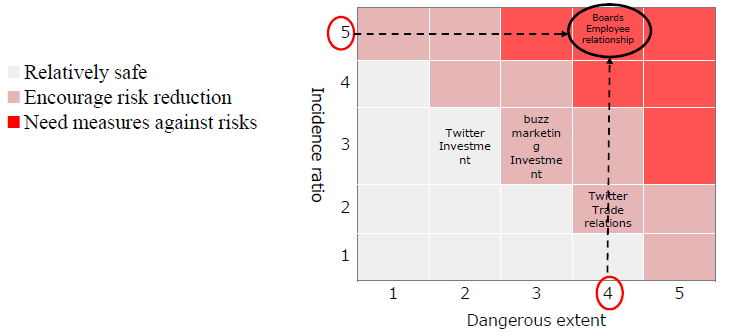
Step 3 is Identification of Risk Factors (or possible causes). For this purpose, possible ways of causing risks, i.e., (bad) reputations in the present case, are thought of aggressively by using the subversion analysis. We try to generate ideas for making and spreading (bad or good) reputations. The Authors are using (modernized Contradiction) Matrix 2003 developed by Darrell Mann.
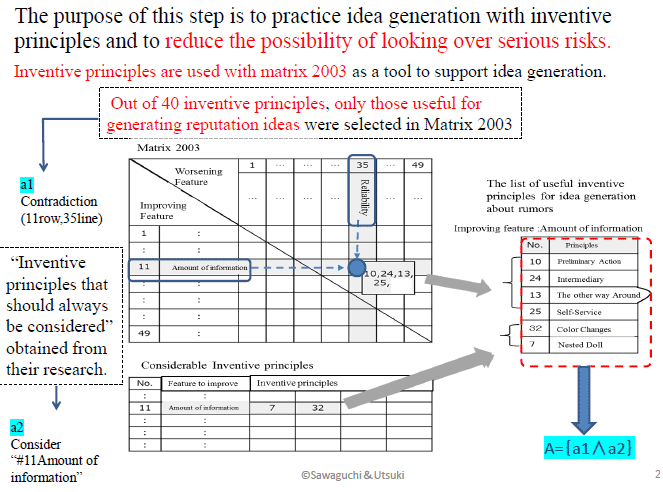
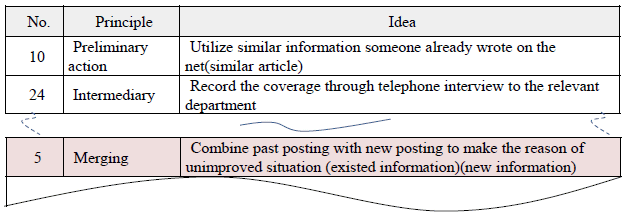
Step 4 is Making plan of proposed measures. In this step Authors use the Failure Tree Analysis (FTA), as shown in the figure (below) for covering all critical causes. (The ideas generated in Step 3 serve to make the nodes in the Failure Tree.) Then for the risk factors at the lowest levels, possible measures need to be considered. Three types of measures against bad reputation risks are considered as shown in the table.
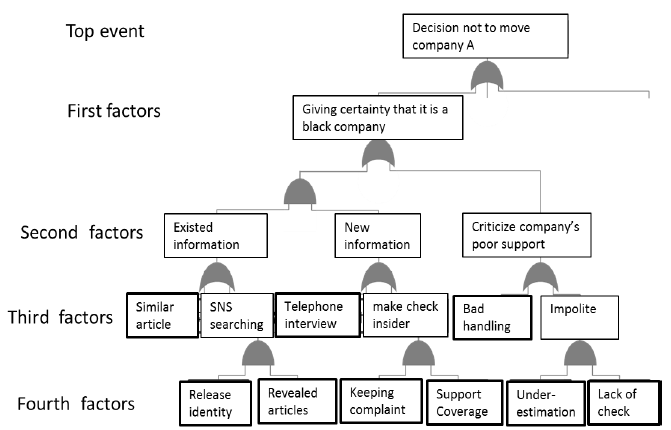

The Authors describe a case study of evaluation of the proposed method, but I skip it here.
*** This is a nice paper showing the intentions/approaches and concrete processes for the management of unknown risks in an area emerging and changing dynamically.
B9. Applying TRIZ and Lean Tools for Improving Development Processes. A Case Study from Industry: Improving the Testing Process for SW and HW-related Products
Martin Kiesel (Siemens AG, Germany), Jens Hammer (Friedrich-Alexander-Universität Erlangen-Nürnberg, Germany) ![]()
The Authors' Abstract is as follows:
Based on evolving technologies and shorter product life cycles, the speed of innovation has increased. Regarding system development of software and hardware-related products, the reduction of complexity and lead time – especially for the testing process – is mission critical for fast delivery and the sustainable success of products and the company as a whole. A methodical approach must be applied to identify the key problems of the current process, achieve a clear understanding of the right future state and elaborate the key levers for improvement.
In this paper we provide a case study in Siemens AG for improving the testing process for a specific project. We apply TRIZ methods (i.e. Ideality, Cause Effect Chain Analysis) and combine these with the Lean Approach (i.e. Value Stream Mapping). The operational result is a set of action items that significantly reduces the necessary testing time.
Furthermore, the specific case study is used to derive a framework for systematic improvement projects in system development. The framework was applied in different projects and provides ideas for scalability depending on specific concerns and boundary conditions of the improvement project.
This is an excellent paper demonstrating the integral use of Lean and TRIZ. Siemens AG seems to have rich experiences of using both Lean and TRIZ, and the paper is written in a compact, generalized, and conclusive style. I will quote most of their slides adding brief introductions.
The paper addresses the field of developing systems involving both hardware and software. For developing the software, the Authors have already used the Lean methodology, stating its major goal as follows:
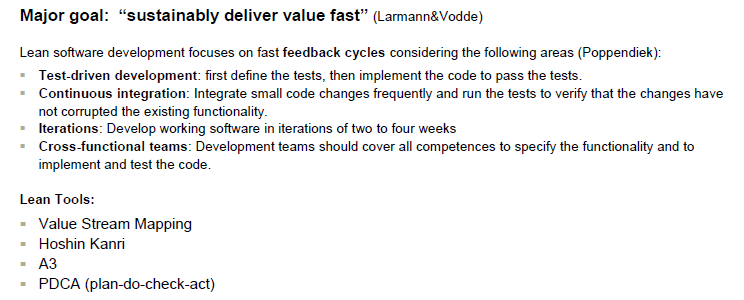
The problem they now want to improve is, as stated in their Abstract, shown in the following slide (below left). The slide (below right) is the scheme of the target system to be developed and tested.
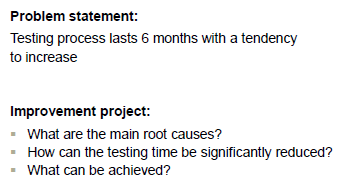
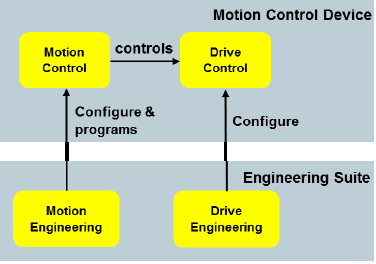
For solving this problem, they organized a special project and applied Lean and TRIZ together. The project set up was defined by an architect (with TRIZ and Lean experience) in close cooperation with a TRIZ-expert/-moderator. A cross-functional team of 10 persons was organized; they cover the whole development and test chain in order to incorporate all of the relevant know-how, experience, and to create a basis for the acceptance of the final measures. The working mode of the project team is shown in the slide (below left), where Kickoff meeting for 1 hour, 3 Workshops (each for half a day with the team and for 2 hours of summary meeting), and Final presentation of the results for the stakeholders. The approach of the project is shown conceptually in the slide (below right). (VSA stands for Value Stream Analysis in Lean methodology.)
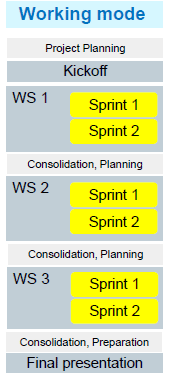
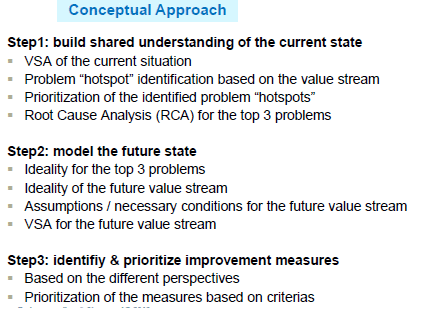
The current state of software development & Testing is represented in the form of Value Stream Mapping in the slide below. This is a standard Lean way of representing Who do What (tasks with dependency and sequence) and When. In contrast to the 4 weeks of Development and Integration, the period of Testing (T1, T2, T3) is 32 weeks long and tends to become even longer.
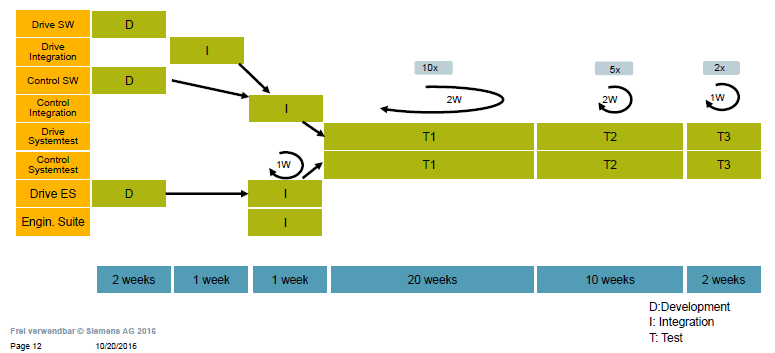
The future (or target) state of the development & testing is formulated finally as shown below.
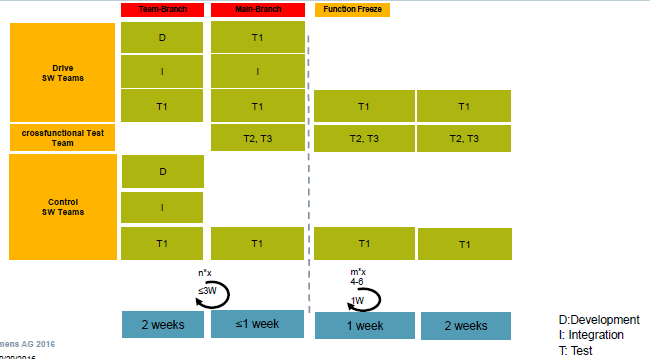
For deriving measures for achieving the target state, the Authors write the following methods were useful:
- VSA is very powerful for these types of problems
- The dedicated problem-specific “deep dive” with RCA provides a holistic view of the problems
- Considering Ideality at different abstraction levels is helpful to generate ideas with different levels of detail
- The pairwise usage of RCA & Ideality with a defined scope and at different abstraction levels has proved to be a good thinking tool
- The A3 report is a good method to combine the different aspects of analytical current and future state
Identification of measures (i.e., solutions) and aspects of them are guided as follows:
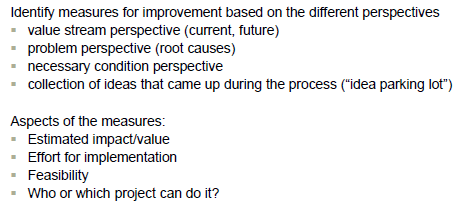
The results and implications of the present project are summarized as: The working model of the present project was guided by Lean. And it has been applied to various improvement projects, and has been generalized into 'Lean Working Model'. And the methods useful in such Improvement projects are found as follows depending on the scale of the problem (or sub-problem).
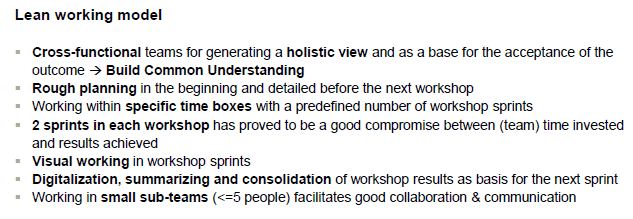
small footprint:
medium footprint:
large footprint:
- Use RCA and Ideality for a specific scope
- Generate all information to cover a full A3 report
- Model current state e.g. using VSM
- Identify the visible key problems
- Analyze the root causes using RCA
- Model the Ideality for the key problems
- Model the future state with different perspectives (VSM, Ideality of the target state, boundary conditions of the target
state)- Make clear what resources are available and which constraints must be regarded (innovation situation questionnaire)
- Generate information for an adequate ideality and future state using the 9-screen approach
- technical system evolution trends (make clear “the voice of the product”)
The Authors conclude as follows:
*** This paper is excellent in demonstrating how to conduct improvement projects and how to analyze and solve (process) problems with integral use of Lean and TRIZ. Lean is used as the framework while TRIZ for enhancing the method. We can learn a lot of experiences and know-how in this paper.
B10. Roadmapping the Disruptive Innovation Technologies Based on CV of Resource
Jianguang Sun, Yu Wang, Lizhen Jia, Runhua Tan (Hebei Univ. of Tech., China)
The Authors' Abstract is as follows:
Different from the sustaining innovation, disruptive innovation is a kind of cheap, convenient and simple product innovation. The realization of the technology can make new corporations achieve successful entrance into the market and effective growth. Because the existing disruptive innovation of technology forecasting and implementation method have not carried on the analysis of the system resources, the realization of the effectiveness cannot be guaranteed.
This paper carried out in-depth research on the system resources of the disruptive innovation process, especially on the coefficient of variation (CV) of the resources, combined the decomposition and analysis methods of the existing technology system, used the TRIZ tool and established a destructive innovation technology forecasting process model that is based on the resource analysis. Finally, an innovative case of an electric screwdriver was presented to validate the proposed theory.
The case study may be useful for us to understand the method proposed in this paper. Electric screwdrivers are chosen for this study. A typical commercial, and hence high-end performance, electric screwdriver is show in the figure. The present method uses Resources as the key factors. Resources may be categorized generally in six classes as shown below. In the case of Electric screwdrivers, the six features shown in the right may be assigned for these six categories.
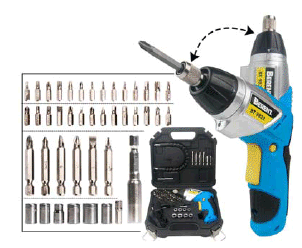
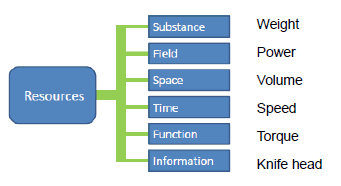
Then a series of commercial screw drivers are surveyed, and their values of features are summarized in the table (below left). The data are then normalized by use of the average values for each category, as shown in the table (below right).
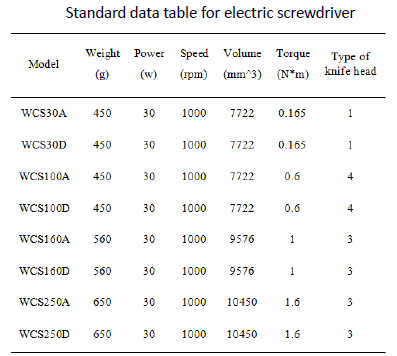
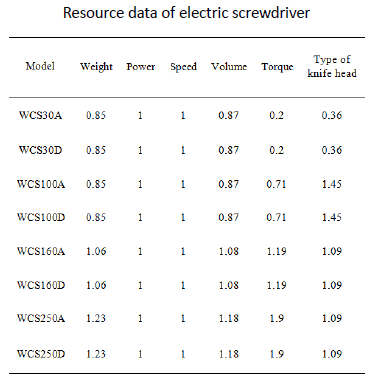
Then for each category, the Coefficient of Variance (CV) is calculated by 'standard deviation' / average, as shown below. The large CV values for Torque and Knife head reflect the fact that these features are already explored much to adapt to various customer needs. Power and Speed, on the contrary, have minimal CV values among the six, and are interpreted that these features have been left unexplored and hence have possibilities of future disruptive innovation. For this direction, two ideas are suggested, i.e., small capacity battery and low speed, intending to make the new product cheaper and more portable.
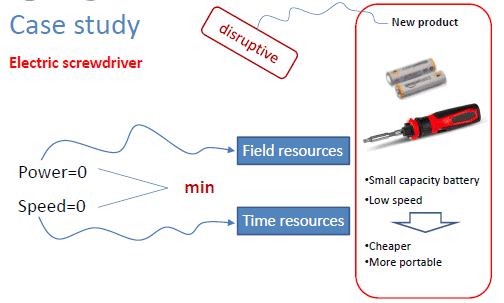
*** I am not sure of the effectiveness of this method. But this paper fits well with the methodological needs in China (and many other regions in the world) for creating disruptive innovation initially at the low-end of customer requirements.
B11. Towards Experience Capitalization for Inventive Problem Solving
Pei ZHANG (LGeCo (Design Engineering Lab.), France), Cecilia ZANNI-MERK (SDC Team, ICube, France), Denis CAVALLUCCI (INSA Strasbourg, France)
This paper puts stress on the importance of Knowledge Representation (KR) for making experiences of people reusable (as shown in the slide below) and aims at building up a software system usable by novices for inventive problem solving.
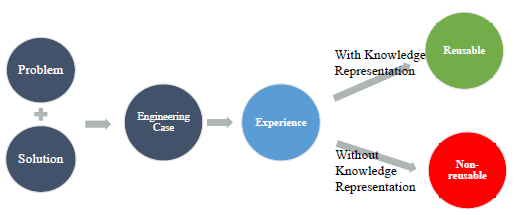
The Authors' Abstract is quoted here:
In this paper, we propose a framework to represent an engineering case (the inventive problem solved using TRIZ methodology) in terms of IDMItem (Inventive Design Method Item) utilizing Set of Experience Knowledge Structure (SOEKS) as a knowledge representation to capitalize and reuse inventive design experience. TRIZ is a systematic problem solving methodology but the usage of it often requires expertise thus difficult for novel users, especially at a high level of abstraction. Besides, the impossibility of recording information and rules related to problem solving results in the inefficiency and duplication thus wastes valuable resources such as time. Therefore, in this paper, we explore the implementation of IDMItem with SOEKS which will provide the possibility of the capitalization of experience that will support more efficient and simpler problem solving.
The paper explains the architecture of the system with detailed description of the knowledge representation method with special terms, and is rather difficult to introduce it here. The main part of the system handles the Technical Contradictions and Inventive Principles, with the system architecture illustrated in the following slide:
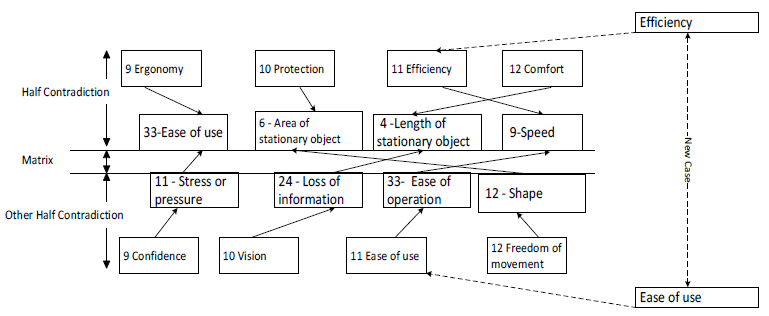
The main (left) part of the slide shows the representation scheme of already-implemented knowledge of experience related to the Contradiction Matrix. 'Half Contradiction' represents the parameters to be improved and 'Other Half Contradiction' the parameters getting worse. Various parameters in user's terms are converted into Generalized (standard) parameters of the Contradiction Matrix; such experiences of parameter conversion can be accumulated in the system and are utilized to help users afterwards. The 'Matrix' in this figure stands for the links between the Generalized Parameter to be improved and the one to get worse and serves to recommend some Inventive Principles. Many cases of experiences of problem solving can be learned and accumulated in the present system. And hence, new cases can be supported with the software, as shown in the right part of the slide.
*** The present study aims at building a sophisticated software which guides (beginner) users to interpret their parameters in the Matrix's standard ones. I wonder, however, a written table of examples of user parameters could be more illustrative for (beginner) users than sophisticated blackbody tools.
Last updated on Jul. 18, 2017. Access point: Editor: nakagawa@ogu.ac.jp